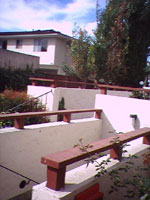Check out our review of the LG VX9900 "enV" which replaced the V in Novemeber 2006.
From time immemorial, Verizon had the most lackluster selection of phones, but their quality of service and fast data offset their tepid handset offerings. This year, Verizon has turned things around with a selection of truly compelling phones that have been released or will be released by Q1 2006. The LG VX9800 is one of those hot new phones, and we're ecstatic it made it to our shores rather then remaining in Korea, where all the amazing but unobtainable CDMA phones live.
The VX9800 has a long laundry list of compelling features, including a color outer display, a stunning 320 x 256 pixel landscape oriented inner display, Text to speech, EVDO, excellent speakerphone, Bluetooth, stereo speakers, 1.3 megapixel camera with flash, 56 megs of available memory, miniSD card slot, MP3 player, voice recorder, Verizon Wireless Sync compatibility, extremely sturdy build and best of all a QWERTY keyboard with dedicated number row inside. It was announced in the US on the Verizon network on Sept. 20, 2005 and appeared in most Verizon stores early October. Verizon targets this $299 with new activation phone at those who need HTML browsing and easy messaging but don't want the price tag, added heft or complexity of a PDA phone such as the Samsung i730 Pocket PC Phone or the Palm Treo 650. The high resolution 262,000 color inner display, stereo sound and strong performance are also perfect for multimedia mavens, and it's currently the best phone on the market to take advantage of VCast media on Verizon's EVDO network. The VX9800 is currently Verizon's most expandable feature phone. You can save photos and videos taken with the camera directly to the miniSD card by default. There's no need to email them to a desktop email account or use Verizon's web-based free service; just pop the card in your PC's card reader to view, edit and manage them. And you can copy your MP3 library to the card using your computer and a card reader. | 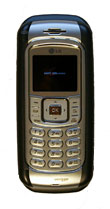 |
Design and Ergonomics
The VX9800 looks like a candy bar phone yet it's really a clamshell phone that opens on the long side rather than top to bottom and has a full QWERTY thumb keyboard inside, similar to the Nokia 9300 design. It's a great deal smaller than the Nokia though it's a bit larger than most feature phones.
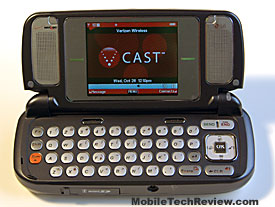
The LG weighs 5.19 ounces and measures 4.57 x 1.97 x 1.0 inches. That's heavy for a cell phone but light by PDA phone standards. Once you feel the build quality and sturdiness of this device, you may not complain about the weight. This phone is built like a tank, and feels much better than the GSM network LG F9100 offered by Cingular. In fact, the VX9800 is much better throughout: the F9100 has a slider rather than clamshell, a single display that was oddly offset when the device is open, no dedicated number row, no expansion slot and no Bluetooth.
Two large hinges hold the two halves of the clamshell together and there's no lateral movement or play in either open and closed positions. The display locks to a 45 degree angle and can also lock flat open for easier texting. The 45 degree angle is ideal for speakerphone use, video and MP3 playback when sitting on a desk or table. Speakerphone automatically turns on when you open the clamshell and turns off when you close the phone. When playing MP3s through the speakers, you'll want to keep the unit open since the speakers are on the inner display surface.
The Samsung i730 and LG VX9800 |
Back of the LG VX9800. Note the large camera lens and portrait / macro slider. |
When the unit is closed, it does double duty as a candy bar phone and you can send and receive calls, initiate voice dialing, dial using the roomy external number pad with raised, lighted keys, and navigate a subset of the LG's menus using the outer LCD. You can even use T9 if you wish, though the QWERTY keyboard beckons for all your input needs. You can read text messages on both the inner and outer displays, change Bluetooth settings by pressing the down arrow on the directional pad, view call history, access contacts, take photos and videos- no need to open the clamshell. The phone has a camera quick launch button on the left side along with a volume rocker. When in certain apps the volume rocker changes context: in the web browser it acts as the page up / down control and it changes photo orientation in the camera application.
Open the clamshell and you'll have full access to all menus, the keyboard and the better than QVGA display. The inner clamshell has a direction pad on the right, call send and end buttons and two soft keys for messages and contacts when in the main screen, and other contexts in other menus and applications. You can easily dial a number with the clamshell open: simply enter numbers and hit the send button. As with most phones, the d-pad functions as an application quick launch pad when in the main screen, offering quick access to the web browser, Verizon's Get It Now service, Pix and Flix (camera, photo / video viewer and VCast) and Calendar.
The miniSD slot is located on the right side (under a protective plastic door) as is the 2.5mm stereo headset jack. No headset is included, but you can use standard mono headsets or LG's stereo headset which is perfect for MP3 playback. The jack uses a 3 ring connector that's relatively long, and the only 3rd party 2.5mm headsets we found which worked are Motorola's HS120 and a Jabra headset.
Keyboard
The VX9800 has a full QWERTY thumb keyboard that's a joy to use. It's one of the best we've ever used on phone or PDA and in a few hours I was typing at 45 wpm. The spacebar, located to the right rather than dead center is the keyboard's only oddity. As a fast touch typist, I was sure that would be a deal breaker but acclimated to it in an hour or two. Since the phone has a dedicated number row up top, there's no need for num lock, and the phone has shift and shift lock as well as a Symbol key. The Fn key launches a list of your 10 favorite applications, which you can customize. Like the outer keypad, the silver keys are backlit with light blue letters and you can adjust the timeout from a few seconds to never turn off. The key lighting is very effective yet unobtrusive, and all keys are easy to see in the dark.
Reception, Voice and Phone Features
CDMA LG phones generally have middle of the road reception. The VX9800 does one better, offering strong reception compared to other recent Verizon offerings despite the internal antenna. Though it might not beat the top RF Motorola V710 and E815, it comes reasonably close. It beat out the LG VX8100, Treo 650 and the Samsung i730 and always offered excellent incoming and outgoing call quality and volume. Voice quality through the full duplex speakerphone is the best we've heard and call recipients had no idea we were using speakerphone, even when calling from a car. The phone can be set to auto-answer when the flip is opened. When the flip is opened, the LG will automatically switch to speakerphone mode and the phone will not hang up when you close the flip— so you can converse using speakerphone in the car, then close it and talk normally once you leave the car. Speakerphone isn't available with the flip closed.
Like the LG VX8100 we recently reviewed, the VX9800 has voice command software and text to speech. You need not record voice tags since the phone uses true voice command which works rather well, even over Bluetooth headsets. You can tell the phone to call someone in your contacts list, digit dial, call voicemail (it will tell you if you have messages and how many). Text to speech can state an incoming caller's name or phone number if desired and can read text messages to you. The phone uses a female voice with sometimes amusing pronunciation but overall it's very usable, even over Bluetooth.
The phone's address book can hold up to 1000 contacts with fields for name, 5 numbers, 2 email addresses, notes, group and picture ID. You can assign a photo to a contact as well as a customized ringtone for voice and a customized tone for incoming messages. You may also assign contacts to groups; either one of the canned groups or one of your own making. In addition, the LG has 99 speed dial slots, with the last three assigned to commonly used Verizon functions (#BAL, #MIN and #PMT) and 1 assigned to voicemail. There's also a basic calendar with day, week, and month views. You can create your own appointments and reminders and set recurrence as needed.
Data: EVDO, VCast, Browsing and Messaging
The LG has separate voice/1xRTT and EVDO signal strength meters. In our San Francisco Bay Area haunts, EVDO is live and we got excellent throughput for VCast video and web browsing. The large, vivid display and stereo speakers are the perfect companions for VCast video and you'll have no trouble hearing soundtracks in all but very noisy locations.
The phone's OpenWave 6.2.3.2 web browser is fast and renders pages in an attractive manner. The browser uses Verizon's Mobile Web 2.0 service ($5/month or included in the $15/month VCast plan) and their VZW Today start page with links to news, weather, email, sports, entertainment and more. The browser supports standard HTML web sites as well as WAP sites and offers SSL encryption, but doesn't support Javascript. Hint: to visit the web site of your choice, select the Search tab in the browser, then the Go to URL function to enter any web address you wish. That's not exactly intuitive, alas. You can also enter web site URLs into your favorites list, thankfully.
The included IM client allows you to chat on AIM, MSN and Yahoo instant messaging. As with most phone IM clients, it uses text messages to send and receive IMs. These messages aren't included as part of Verizon's "In" messages, so opt for one of their non-"In" text message plans rather than an "In" package (they offer several non-"In" text message packs, though these aren't listed on their web site). Messages were reasonably quick over an EVDO connection (since these are text message based, connection speed shouldn't be important), though it's not nearly instantaneous as true IM-ing using a smartphone or PDA phone. The client can stay active in the background, notifying you when new messages come in. The keyboard makes IM-ing a breeze and you may find yourself leaving plain old text messaging behind.
Oddly, the phone doesn't come with an email client and currently there isn't one available for download under Get It Now. Since the phone is new, Verizon may yet offer an email client. We certainly hope they do, because the only other alternative is Verizon's $20/month Wireless Sync service which you'll install on your PC and phone and then set your PC to redirect emails to the phone. Wireless Sync also syncs Outlook data from your PC to phone which is an attractive proposition to business users who need both email and PIM syncing (though Wireless Sync isn't compatible with all corporate firewalls). Those of you who wish to use popular email services such as Hotmail, Yahoo! Mail and AOL Mail are in luck as the browser offers support for these. If you're a GMAIL fan, simply go to gmail.com to check your mail.
Display, Sound and Multimedia
The inner display is phenomenal: very bright, contrasty and colorful. It's excellent for viewing photos and videos. By feature phone standards, this is a very high resolution display that beats Pocket PCs by a few pixels, coming in at 320 x 256 pixels. The landscape TFT LCD measures 2.4" diagonally and displays 262,000 colors. Text is sharp and easy to read, with a default of 15 lines and refresh times are good for video.
The outer display is very good by external display standards. The 65,000 color TFT LCD has a resolution of 160 x 128 pixels and displays 9 lines of text. It's bright, colorful and easy to read. Since the inner and outer displays are TFT, they are at their best indoors, though they remain readable outdoors. You can set inner and outer display backlight timeouts independently and you can set different wallpapers for each display. If you wish you can use your own images (or videos taken with the camera) as wallpapers. These can be on a card and images need not be taken with the phone's camera.
The LG VX9800 sound system is super by phone standards. The large stereo speakers are plenty loud for video and MP3 playback, though you'll get the best sound from stereo headphones. In fact sound through headphones (we used the Motorola HS120 since we couldn't get a hold of the LG stereo headset) is excellent for MP3 playback. Get yourself a large miniSD card and you've got a good MP3 player with EQ, shuffle, repeat and visualizer. The LG comes with 7 EQ settings including 3D surround, rock, jazz and classical. If there were a way to create playlists, the MP3 player would be complete.
Video playback is excellent and the screen resolution and quality make a good experience even better. The included video player can play videos taken with the camera, videos downloaded through Verizon's VCast service (mostly .wmv format) and streaming VCast video.
Camera
US camera phones aren't generally anything to write home about, though Nokia's megapixel offerings are quite nice. What a pleasant surprise the VX9800's 1.3 megapixel CMOS camera was. Better than the LG VX8100's and even one of my personal favorites, the Nokia 7610, the VX9800 takes very sharp photos with good color accuracy and lighting. Like most cameras, it does best in moderate to well lit environments, though low light shots taken with and without the flash aren't horribly grainy but they do lose some color. In general, the camera takes photos that look good on your monitor, not just the phone's LCD and they're worth saving.
The LG offers a variety of camera controls and has an LED flash which helps a bit at close range in poorly lit environments. You can adjust brightness, white balance, turn on night mode, use color effects, enable/disable the flash and change or turn off the shutter sound. The phone can take photos at a maximum resolution of 1280 x 960, and can shoot photos at a variety of lesser resolutions. You can set the camera app to save photos and videos to either internal memory or the miniSD card. Of course, you can send your photos and videos via MMS, or send them to Verizon's PIX Place as well. There is no shutter lag and images save very quickly.
We weren't wowed by the VX8100's videos but the VX9800's are head and shoulders above not only that camera phone but much of the US competition. The camera can shoot video with audio at 320 x 240 and 176 x 144 resolutions at 15 fps in .3G2 format which is supported by Quicktime on the desktop. Videos, even at the higher resolution were smooth not blocky, with good color, sharpness and sound quality. Nice going, LG! Video clips are limited to 15 seconds in length, even when saving to a card, which is a shame.
|  |  |
Bluetooth and miniSD Slot
Yes, the LG VX9800 has Bluetooth, and by Verizon's standards, it's a bit less hobbled than usual. The phone supports headset and hands free profiles for use with Bluetooth headsets and car kits. We tested the LG with the Gennum Zen, Motorola HS820, Motorola HF800 car kit, Plantronics M3500 and South-Wing SH305. All worked well, offering good range, volume and clarity as well as compatibility with text to speech and voice command, though the South-Wing did occasionally suffer from static and didn't offer as good range.
Surprisingly (for Verizon), the LG also has Bluetooth OBEX support for vCard transfer to and from other phones, PDAs and computers. You won't be able to push any other data using OBEX however. We sent contacts to the phone using an HP iPAQ hx2490 and Outlook on the desktop and it worked well with two caveats: phone number fields won't transfer unless you remove spaces, dashes and parenthesis, and the phone accepts contacts with the last name first (handy for viewing but weird for voice dialing). Bluetooth DUN (dial up networking) is enabled, though it seems Verizon may have changed the way their servers handle authorization so you may not be able to take advantage of DUN. Of course, DUN is prohibited by most mobile carriers including Verizon so use this at your own risk.
The fully functional miniSD slot is another surprise on a Verizon phone. You can save photos and videos taken with the camera as well as recorded sounds by default to the card. This is an improvement over the LG VX8100 where you had to save these to internal memory then transfer them one by one to the card. In addition you can put your MP3s on the card using a card reader on your computer (put them in the MY_MP3 folder and don't create any subdirectories in that folder because the phone won't see them). When you insert a card into the VX9800 for the first time, it will create the necessary directories for you, so you need do nothing. Videos are saved to the MY_FLIX folder, photos to MY_PIX, sounds to my_sounds and MP3s to MY_MP3. Since Verizon wants to sell you ringtones, there's no way to transfer sounds or MP3s to internal memory unless you want to try the free Bitpim application on your computer to manage your phone's internal memory. Bitpim is very powerful, but not for the faint of heart, however.
Battery Life
The standard 1300 mAh Lithium Ion battery is generous by phone standards. Our two units managed 3 days on a charge with heavy use (each day we were talking on the phone for an hour, surfing the web for an hour, listening to MP3s through headphones for 30 minutes, playing games for 20 minutes and watching a few VCast videos). With light use, the phone lasted 4 days on a charge. If you're in an EVDO area as are we, you should get this kind of battery life since EVDO is easy on the battery. If you're in a fringe area or one where Verizon is building out the service, you'll get considerably shorter runtimes because the phone will hunt for that trace EVDO signal throughout the day. This is true of all Verizon phones with EVDO we tested (Audiovox XV6600, Samsung i730 and LG VX8100), not just the VX9800. Should you need even more stamina, LG offers an extended 2100 mAh optional battery available for purchase separately.
Bluetooth didn't affect battery life greatly because the phone sleeps the connection when not active. Playing games and watching VCast videos did drain the battery more quickly than other activities, as will using the camera's flash very frequently. While most PDA phones have flight mode, few feature phones offer it. The LG has flight mode (called "standalone mode"), so you can turn off the phone's radio for use on airplanes or anywhere else you'd like to use the phone's PIM, camera, MP3 player, gaming and other features without having the phone's wireless radio on.
Other Software
In addition to Contacts, Calendar, IM, camera, photo viewer, video viewer and the web browser, the LG comes with a notepad, alarm clock, calculator, EZ Tip Calc, World Clock. You can download other BREW (Java) applications including games using Verizon's Get It Now service. LG includes "Name Card Reader" which is really a business card reader that works in conjunction with the camera. Yes, it's a nifty party trick but it's actually useful too. Put the camera in macro mode using the switch on the back, take a photo of a business card and the VX9800 will then use OCR (optical character recognition) to turn the words in the image to text. It will walk you through assigned the text on the business card to fields in the address book.
Conclusion
If you're looking for something short of a PDA phone but need more than a feature phone, the VX9800 should be on your short list. The superb keyboard makes messaging and data entry easy and the phone's multimedia prowess put it above the feature phone pack. The unit has excellent build quality, great displays, an impressive camera that does a great job of both photos and videos, Bluetooth and an MP3 player. Throw in EVDO and VCast and you've got an excellent communications and entertainment tool, as well as a strong phone with good voice manners, excellent speakerphone and strong usability and one-handed operation. Heck, I liked it so much, I bought one!
Pro: Excellent keyboard, strong built quality, clever industrial design. Candy bar ease of use is good, with a large lighted number pad, d-pad and easy access to basic menu functions, Bluetooth and the MP3 player. Speakerphone is top notch, as is voice quality and volume. Camera takes photos and videos that are worth saving. Bluetooth works reliably and is less hobbled than usual for a Verizon phone. Good phone reception, great MP3 playback quality, miniSD card slot is great for transferring photos, videos and MP3s. Good IM support with included client. Backlit keyboard eases nighttime texting. Browser can handle normal HTML web sites as well as WAP.
Con: No email client included. Though not a behemoth, the phone isn't petit or light. IM client uses text messages and Verizon's text message plans aren't a bargain.
Price: $299 with 2 year contract, $469 without contract
Web Site: us.lge.com, www.verizonwireless.com
Specs:
Display: Outer display: TFT color LCD, 160 x 128 pixels (9 lines). Inner display: TFT 262K colors, 320 x 256 pixels.
Battery: Lithium Ion rechargeable. Battery is user replaceable. 1300 mA. 2100 mA extended battery available for purchase. Claimed talk time: 4.16 hours. Claimed standby: 8.3 days.
Performance: Undisclosed processor. 128 megs flash ROM, 64 megs RAM with 56 available.
Size: 4.57 x 1.97 x 1.0 inches. Weight: 5.19 ounces.
Audio: Built in stereo speakers, mic and 2.5 mm headphone jack. Voice Recognition software included. Full duplex speakerphone (works only when clamshell is open). 72-Chord Polyphonic Sound Support, Voice Memo Recorder (1 Minute Each; Up to 200 memos total). Has vibrate feature and comes with 16 ringtones.
Phone: Digital dual band: 800 MHz CDMA and 1900 MHz PCS bands (no analog). Supports both EVDO and 1xRTT for data. Has Get It Now and VCast and can run BREW apps.
Camera: 1.3 MP camera with LED flash. 4x digital zoom. Camera Resolutions: 1280 x 960, 640 x 480, 320 x 240, 176 x 144, 160 x 120 pixels. Video resolutions: 320 x 240 and 176 x 144 pixels, 3G2 format. Close-up switch on lens for macro shots.
Bluetooth: Supports headset, handsfree, VCard transfer over OBEX and DUN profiles. Bluetooth 1.1, class 2 radio.
Software: Contacts, Calendar, text and MMS client, instant messaging (AIM, MSN and Yahoo), photo and video viewer, camera, Get it Now (download Pix and Flix, ringtones, BREW games and other apps) and Open Wave HTML/WAP web browser for use with Verizon's Mobile Web service 2.0. In addition, T9, Notes, World Clock, Alarm Clock, EZ Tip Calc, Calculator, Name Card Reader (take macro photo of business cards) and Voice Command.
Expansion: 1 miniSD (Secure Digital) slot.
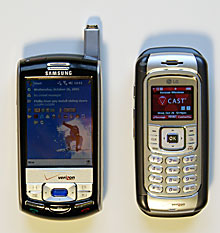
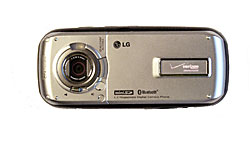

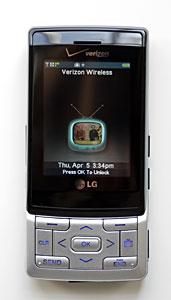
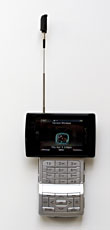
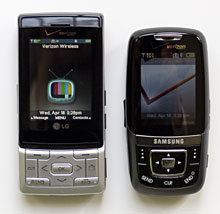
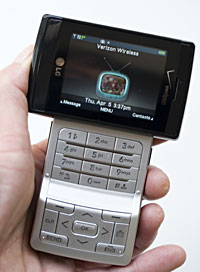

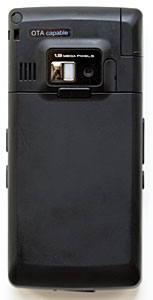

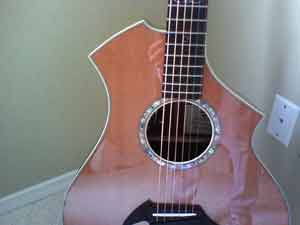


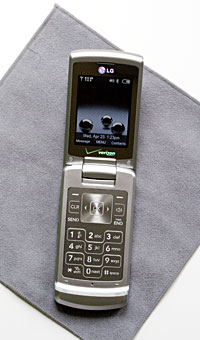
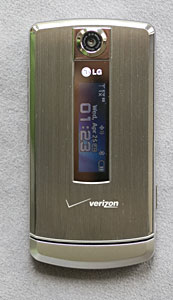
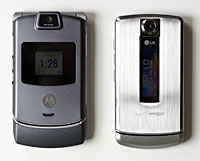
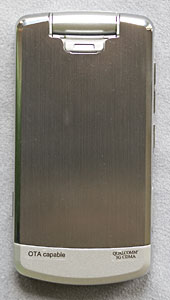
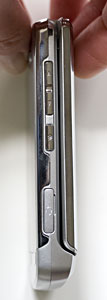


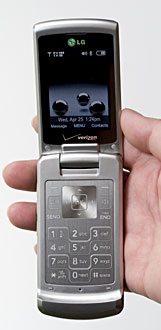





 Empower plans to ship a $200 Linux-based PDA with a color display by December. The PowerPlay 1x is based on a dual-core RISC/DSP Texas Instruments OMAP5910 processor, along with the company's LEOs (LinuxDA Embedded Operating System) software platform. Empower has previously sold sub-$100 PowerPlay PDAs based on Palm-compatible hardware, direct and through large Canadian retailers.
Empower plans to ship a $200 Linux-based PDA with a color display by December. The PowerPlay 1x is based on a dual-core RISC/DSP Texas Instruments OMAP5910 processor, along with the company's LEOs (LinuxDA Embedded Operating System) software platform. Empower has previously sold sub-$100 PowerPlay PDAs based on Palm-compatible hardware, direct and through large Canadian retailers. Empower will also offer a development version of the PowerPlay 1x, featuring a module with LCD and processor (shown at right) and the LEOs SDK (software development kit). The SDK includes a Linux 2.4.21 kernel with source and drivers for framebuffer, touchscreen, UART, IrDA, SD, USB host, USB client, power management, RTC, button, keyboard, and console. It also includes TI's DSPLink driver for programming the DSP. Additionally, it includes LinuxDA graphics library, sample programs, hand-writing recognition, a software keyboard, and an IP stack.
Empower will also offer a development version of the PowerPlay 1x, featuring a module with LCD and processor (shown at right) and the LEOs SDK (software development kit). The SDK includes a Linux 2.4.21 kernel with source and drivers for framebuffer, touchscreen, UART, IrDA, SD, USB host, USB client, power management, RTC, button, keyboard, and console. It also includes TI's DSPLink driver for programming the DSP. Additionally, it includes LinuxDA graphics library, sample programs, hand-writing recognition, a software keyboard, and an IP stack.




